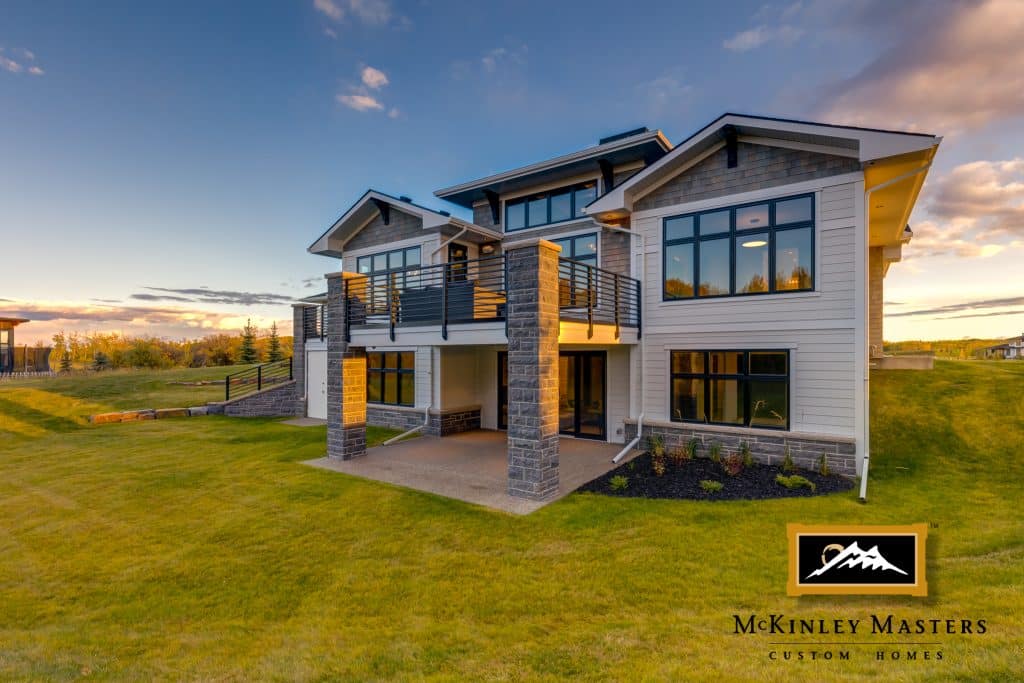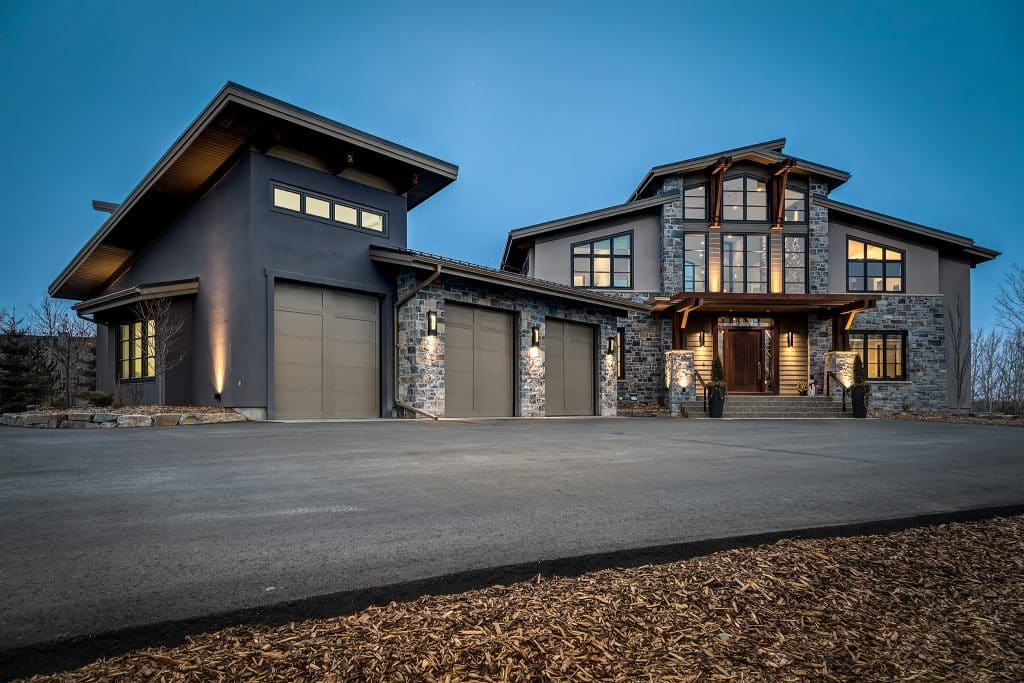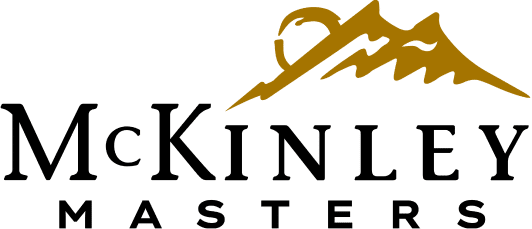
Calgary is a city of weather extremes—frigid winters, dry air, and rapid temperature swings brought on by Chinooks. While these conditions make for dramatic skies and crisp mountain views, they also pose serious challenges for home design. If you’re building a custom home in Calgary, accounting for the local climate isn’t just smart—it’s essential.
Whether you’re breaking ground on your dream home or planning a major renovation, climate-aware design will affect your comfort, energy bills, and long-term property value. In this blog, we’ll explore how Calgary’s climate shapes everything from insulation and window placement to HVAC systems and structural choices.
Quick Overview: Why Climate Matters in Home Design
Designing a home in Calgary goes beyond aesthetics. Luxury can always be part of the equation, but durability is also important. A well-built custom home should perform in every season. It’s not just about looking timeless. In Calgary, where one week can swing from -25°C to +10°C due to Chinooks, building for the weather isn’t optional. It’s essential.
Calgary’s Unique Climate Conditions
Before you even start worrying about interior style or architectural plans, gain an understanding of the climate in Calgary to build a home that lasts. The weather in the city can influence everything from indoor comfort to structural integrity.
How Calgary’s Climate Impacts Custom Home Design: Cold Winters & Chinooks
It’s no secret that Calgary winters are harsh. Extended cold snaps are followed by sudden warm spells caused by Chinook winds. These rapid temperature fluctuations can cause materials to expand and contract, resulting in wear and tear over time. A home designed without these shifts in mind may suffer premature cracking, warping, or inefficiency.
Understanding Calgary’s Climate
Calgary’s climate is a study in contrasts, with frigid winters and warm summers creating a unique set of challenges for home builders. The city basks in an impressive 2,896 hours of sunshine annually, making it one of Canada’s sunniest locales. However, it also receives about 411 millimetres of precipitation each year, primarily during the summer months. These climatic conditions necessitate thoughtful construction practices to ensure energy efficiency and durability. Understanding Calgary’s climate is not just beneficial—it’s essential for anyone looking to build a home that stands the test of time.
Dry Air & Moisture Control
The air in Calgary is notably dry, particularly in the winter. This dryness can affect hardwood flooring, cabinetry, and even human comfort. Ironically, the climate also presents challenges with moisture—especially during snow melts and spring rain. Proper humidity control and water mitigation strategies are crucial to save on long-term maintenance costs and energy bills.
Intense Seasonal Swings
From freezing winters to scorching summers, Calgary experiences a wide range of temperatures. Future-proofing your home with advanced energy-efficient systems ensures it remains comfortable and sustainable for years to come. That means insulation, ventilation, and overall energy efficiency need to be at the forefront of everyone’s mind. Every decision—from your window selection to your HVAC system—should reflect the reality of building for Calgary weather.
Climate-Informed Design Considerations

Now that we’ve covered the basics of the local climate, let’s look at how these conditions translate into smarter design choices.
Insulation & Building Envelope Materials
A well-insulated home is essential for maintaining energy efficiency and indoor comfort. Custom homes in Calgary should include:
- Spray foam insulation in attics and crawl spaces
- Rigid foam board on exterior walls and basement foundations
- High-performance weather barriers to protect against air and moisture intrusion
- Triple-pane windows to reduce heat loss
These windows often use gas between the panes to minimize heat transfer and enhance insulation, which is particularly beneficial in colder climates like Calgary.
“In Calgary, insulation isn’t just about comfort—it’s about protecting your investment. Poor insulation shows up fast on your energy bill and in your quality of life,” says one of our lead builders.
Window Placement & Glazing for Natural Light
Window orientation and type have a big impact on energy efficiency. Additionally, large windows can flood your home with natural light, enhancing the ambiance and reducing the need for artificial lighting. South-facing windows can help capture solar warmth in winter, while shading or overhangs protect against summer heat. Low-emissivity (Low-E) glass, thermal breaks, and well-insulated frames help regulate indoor temperature year-round.
Roof Structure & Snow Load
Roofs in Calgary must be designed to withstand heavy snowfalls and prevent ice damming. A steeper pitch, durable underlayment, and proper ventilation make all the difference. Snow guards and heated eavestroughs may also be considered for added protection.
Exterior Siding Options for Durability
Choosing the right exterior siding is crucial for protecting your home from Calgary’s extreme weather. Fibre cement board is a top choice, known for its durability and low maintenance, and it is capable of withstanding heavy rain and hail. Steel siding offers another robust option, providing excellent resistance to pests and mold. For those who prefer a classic look, brick siding combines timeless aesthetics with superior insulation and durability. When selecting siding, consider not just the immediate benefits but also long-term energy efficiency and maintenance needs to ensure your home remains resilient and efficient.
Foundation Protection in Construction
Frost heaving and ground shifting are concerns in colder climates. To safeguard the foundation, it’s wise to include:
- Deep footings below the frost line
- Exterior foundation insulation
- Proper drainage systems and weeping tiles
- Graded landscapes that direct water away from the house
Features That Make Calgary Custom Homes More Energy Efficient

Energy efficiency is not just a buzzword when it comes to Calgary custom homes—it’s a necessity. Efficient homes mean fewer emissions, lower bills, and more consistent comfort through the seasons.
High-Efficiency Energy-Efficient HVAC Systems
Choose an ENERGY STAR®-rated furnace and air conditioner, ideally with variable-speed capabilities. These systems adjust output based on temperature demands and maintain optimal comfort without the cost spikes.
Heat Recovery Ventilators (HRVs)
In a tightly sealed home, ventilation becomes even more important. HRVs remove stale indoor air while bringing in fresh air—without losing heat. They’re perfect for Calgary’s dry winters and improve air quality without compromising efficiency.
Smart Thermostats & Home Automation
Smart thermostats can learn your schedule and adjust temperatures automatically. In Calgary, that means preheating before cold mornings and reducing output during Chinook days. Add-ons like motorized blinds, zoned heating, and leak detectors bring peace of mind and added luxury.
How to Design for Comfort and Efficiency Year-Round
Designing a home that works 12 months of the year requires more than good insulation and a reliable furnace. Here’s a practical approach:
- Start with a Climate Assessment: Understand your lot’s orientation, sun exposure, and wind direction.
- Design with Solar Gain in Mind: Use thermal mass materials like stone or concrete flooring to absorb and release heat.
- Integrate Flexible HVAC Zones: Set different temperatures in separate areas of the home for maximum efficiency.
- Choose Humidity-Tolerant Materials: Use engineered hardwood, fibre cement siding, and VOC-free paint.
- Use Landscaping Strategically: Windbreaks can reduce heat loss, while deciduous trees provide shade in summer.
Mistakes to Avoid When Building in Calgary’s Climate
Even the most beautifully designed home can suffer without proper climate planning. Avoid these costly errors:
- Using standard insulation that doesn’t meet Calgary’s needs
- Ignoring vapour barrier placement or choosing the wrong type
- Placing mechanical rooms in uninsulated areas
- Choosing exterior finishes that are prone to cracking in dry air
- Failing to account for snow load or proper roof ventilation
What Happens When Climate Isn’t Considered in Custom Home Design
We’ve seen it many times—million-dollar homes requiring expensive fixes within just a few years. Cracked drywall, peeling finishes, inconsistent indoor temperatures, and even foundation shifts. These are not design flaws; they’re climate mismatches.
“Some homeowners don’t realise until it’s too late that Calgary’s weather is unforgiving. But when we build with the local environment in mind from day one, we see homes age gracefully—inside and out,” says a senior project manager at McKinley Masters.
Ready to Build a Custom Home That Fits Calgary’s Climate?
Build a custom home. Let it be your sanctuary—warm in the winter, cool in the summer, and built to last through decades of Alberta weather. At McKinley Masters, we believe true luxury lies in longevity, comfort, and thoughtful design. From premium insulation to passive solar layouts, our approach ensures that your home is more than beautiful—it’s intelligently built for a Calgary custom home design.
If you’re thinking about building for Calgary weather, now is the time to bring climate-smart thinking to the forefront. Let’s make a space that reflects your style and protects your investment, season after season.
Flooring Options for Cold Climates
In Calgary’s cold winters, the right flooring can make a significant difference in comfort and energy efficiency. Hardwood flooring is a popular choice, offering both durability and a warm, inviting look. Laminate flooring provides a cost-effective alternative that’s easy to maintain. For areas prone to moisture, such as bathrooms and kitchens, tile flooring is an excellent option due to its durability and resistance to water. When choosing flooring, consider how each option will perform in cold temperatures and its overall impact on your home’s energy efficiency.
Net Zero Certification and Its Benefits
Achieving Net Zero Certification is a mark of excellence in energy-efficient home building. Homes with this certification produce as much energy as they consume, leading to significantly reduced energy costs and a smaller carbon footprint. The benefits extend beyond financial savings; these homes often have higher property values and provide a healthier indoor environment. To earn Net Zero Certification, homes must meet stringent energy efficiency standards, utilizing renewable energy sources, energy-efficient appliances, and advanced insulation materials. Investing in a net-zero home is a forward-thinking choice that pays dividends in comfort, savings, and sustainability.
Community and Neighborhood Considerations
When building your dream home in Calgary, the community and neighborhood are just as important as the house itself. Proximity to schools, public transportation, and amenities can greatly enhance your lifestyle. Additionally, consider the quality of the neighborhood, including crime rates, noise levels, and environmental factors. A well-planned community can offer increased property values, a strong sense of community, and easy access to essential services. Thoroughly researching your potential neighborhood ensures that your new home is not just a place to live but a place where your family can thrive.
By following this plan, the new sections will seamlessly integrate with the existing content, providing valuable information while maintaining a consistent tone and style.
Build smarter. Build stronger. Build for Calgary.
